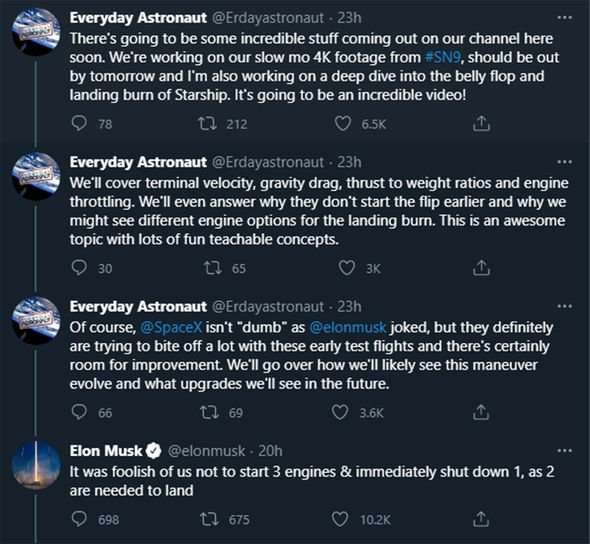SpaceX Starship crash: Elon Musk admits 'foolish' engine mistake that cost SN9 its life






SpaceX Starship crash: Elon Musk admits 'foolish' engine mistake that cost SN9 its life
Starship Serial Number 9 (SN9) finally took to the skies this Tuesday after weeks of delays. SpaceX attempted to launch and land the rocket at its Boca Chica facility in South Texas, more than a month after the crash landing of its previous iteration, SN8. But not all went according to plan as after acing its 6.2 mile (10km) hop, Starship failed to stick the landing
SpaceX fans worldwide were glued to their screens as the stainless steel rocket plunged to the ground belly-side down.
Then, just seconds before hitting the ground, SN9 fired two of its three Raptor engines and flipped upright again for a soft landing attempt.
Instead of slowing down, the rocket flipped almost entirely onto its back and crashed into the launch pad, sending a mushroom cloud of fire and smoke into the sky.
But what at first glance appeared to have been an engine failure, may have been a conscious decision on SpaceX's part.

Tim Dodd of Everyday Astronaut tweeted about the crash after Elon Musk, 49, joked he and his team were "too dumb" about the test flight.
He said: "Of course, @SpaceX isn't "dumb" as @elonmusk joked, but they definitely are trying to bite off a lot with these early test flights and there's certainly room for improvement.
"We'll go over how we'll likely see this manoeuvre evolve and what upgrades we'll see in the future."
Elon Musk replied to the tweet, saying it was a bad call to not ignited all three of Starship's raptor engines.
He said: "It was foolish of us not to start three engines and immediately shutdown one, as two are needed to land."
Mr Musk believes Starship could be the first spacecraft to land humans on Mars.

Towards this goal, SpaceX is pioneering a unique approach to multi-planetary travel.
Starship's upper stage, the Starship spacecraft, will launch on top of the Super Heavy booster rocket.
Much like the company's Falcon 9 boosters, Super Heavy will go to orbit and return back to Earth.
Starship will then fly to destinations like the Moon and Mars, and possibly even beyond.
When landing on Mars or Earth where there is an atmosphere, Starship will perform a belly-flop manoeuvre by falling to the ground belly-side down.
Doing so will slow the rocket down aerodynamically and without having to burn any fuel until the very last moments.
It is, therefore, critical SpaceX nails down the manoeuvre even if it means sacrificing one or two prototype models in the process.
The next Starship in line, the SN10 model is already waiting on the Boca Chica launch pad for its chance to earn its wings.
SpaceX's ultimate goal is to have a fully reusable fleet of Starships that can be launched multiple times a day.
And the Starship explosions do not appear to concern SpaceX too much - the test rockets are expendable after all.
SpaceX engineer John Insprucker said on Tuesday: "We demonstrated the ability to transition the engines to the landing propellant tanks, the subsonic reentry looked very good and stable.
"We've just got to work on that landing a little bit."
Reference: Daily Express: Sebastian Kettley
Articles-Popular
- Main
- Contact Us
- Planetary Existences-2
- Planetary Existences
- TWO REVELATIONS-2
- The Two Revelations
- Jeffery Epstein - The Saga - 9
- Jeffery Epstein - The Saga - 8
- Jeffery Epstein - The Saga - 10
- Universality of Initiation
- The Participants In The Mysteries-2
- The Path Of Initiation
- Initiation and the Devas
- Impeachment Investigators Subpoena White House - Ukraine
- The Fourth Way - Study of Oneself - P.D.Ouspensky
- Discipleship - Group Relations - 2
- The Probationary Path - 2
- The Final Initiation
- The Succeeding Two Initiations
- The Participants In The Mysteries
- Discipleship - Group Relationships
- Discipleship
- Jeffery Epstein - The Saga - 7
- The Fourth Way - Wrong Functions - P.D Ouspensky
- Statues are a mark of honour. Like Edward Colston, Cecil Rhodes and Oliver Cromwell have to go
- Jeffery Epstein - The Saga - 6
Articles - Latest
- US government agrees to $138.7M settlement over FBI's botching of Larry Nassar assault allegations
- WW3 fears skyrocket as Iran official wars Tehran can launch nukes in one week
- Barbados halts £3m plan to purchase Tory MP’s former slavery plantation amid backlash
- Hamas chiefs 'planned to INVADE Israel, kill civilians and form state'
- New Opinion Poll Heats Up London Mayor Race
- Poland ready to host US nukes on Putin's doorstep as Nato and Russia heading for nuclear showdown
- Tory MP resigns after demanding £6,500 to pay off 'bad people'
- Richard Drax to earn millions from sale of Barbados slave plantation
- Met apologises to Stephen Lawrence’s mother for broken promise
- Greek and Turkish delegations meet in Athens as part of efforts to improve often strained ties
- Why £2.5 billion from Roman Abramovich's Chelsea sale STILL hasn't been paid to Ukraine war victims - explained
- Ex-Scottish leader Sturgeon's husband charged with embezzling party funds
- Ousted Myanmar leader Suu Kyi moved from prison to house arrest due to heat
- Vietnamese property tycoon sentenced to death in $27bn fraud case
- All seven British terrorist co-conspirators of al-Qaeda 'dirty bomb' mastermind Dhiren Barot are freed after serving just HALF their jail terms: Thugs were caged for a total of 136 years in 2007 over terror plot to kill hundreds in London and New York





